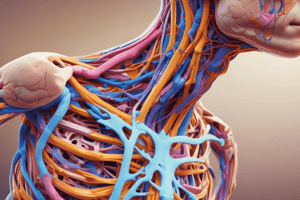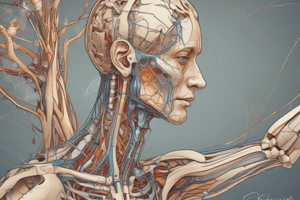Podcast
Questions and Answers
What spinal nerve roots contribute to the formation of the brachial plexus?
What spinal nerve roots contribute to the formation of the brachial plexus?
- C4, C5, C6, C7, T1
- C3, C4, C5, C6, C7
- C6, C7, C8, T1, T2
- C5, C6, C7, C8, T1 (correct)
Which component of the brachial plexus lies in the axilla?
Which component of the brachial plexus lies in the axilla?
- Roots
- Cords (correct)
- Divisions
- Trunks
How many trunks are formed from the roots of the brachial plexus?
How many trunks are formed from the roots of the brachial plexus?
- Two
- Three (correct)
- Four
- Five
Which nerve is formed from the roots of the brachial plexus?
Which nerve is formed from the roots of the brachial plexus?
From which trunk does the suprascapular nerve originate?
From which trunk does the suprascapular nerve originate?
What is the function of the long thoracic nerve?
What is the function of the long thoracic nerve?
What forms the lateral cord of the brachial plexus?
What forms the lateral cord of the brachial plexus?
Which nerve is a branch of the medial cord?
Which nerve is a branch of the medial cord?
What is the anatomical position of the divisions of the brachial plexus?
What is the anatomical position of the divisions of the brachial plexus?
Which spinal nerves are involved in the contribution to the phrenic nerve from the roots?
Which spinal nerves are involved in the contribution to the phrenic nerve from the roots?
What hand position is characteristic of Klumpke's paralysis?
What hand position is characteristic of Klumpke's paralysis?
Which nerve roots are primarily involved in Klumpke's paralysis?
Which nerve roots are primarily involved in Klumpke's paralysis?
What is a significant sensory loss associated with Klumpke's paralysis?
What is a significant sensory loss associated with Klumpke's paralysis?
Which condition is characterized by the absence of autonomic signs?
Which condition is characterized by the absence of autonomic signs?
Which of the following muscles is not paralyzed in Klumpke's paralysis?
Which of the following muscles is not paralyzed in Klumpke's paralysis?
What is the primary surgical concern when approaching the axilla for lymph node excision?
What is the primary surgical concern when approaching the axilla for lymph node excision?
Which of the following symptoms is associated with Horner's syndrome?
Which of the following symptoms is associated with Horner's syndrome?
What causes Erb's paralysis?
What causes Erb's paralysis?
What type of nerve involvement is most affected in Klumpke's paralysis?
What type of nerve involvement is most affected in Klumpke's paralysis?
What hand position is characteristic of Erb's paralysis?
What hand position is characteristic of Erb's paralysis?
Which of the following nerves is not typically implicated during axillary surgery?
Which of the following nerves is not typically implicated during axillary surgery?
What is the typical deformity associated with Erb's paralysis?
What is the typical deformity associated with Erb's paralysis?
Which nerve is NOT part of the medial cord contributions of the brachial plexus?
Which nerve is NOT part of the medial cord contributions of the brachial plexus?
What effect does Erb's paralysis have on the elbow position?
What effect does Erb's paralysis have on the elbow position?
Erb's point is located at which part of the brachial plexus?
Erb's point is located at which part of the brachial plexus?
What is the role of the axillary nerve?
What is the role of the axillary nerve?
Which muscles are paralyzed leading to internal rotation of the arm in Erb's paralysis?
Which muscles are paralyzed leading to internal rotation of the arm in Erb's paralysis?
What is a common mechanism of injury for Klumpke's paralysis?
What is a common mechanism of injury for Klumpke's paralysis?
Which nerve is involved in providing sensation to the outer aspect of the arm?
Which nerve is involved in providing sensation to the outer aspect of the arm?
Flashcards
Medial cutaneous nerve of the arm
Medial cutaneous nerve of the arm
Nerve that supplies sensation to the medial aspect of the arm, originating from the T1 spinal nerve.
Medial cutaneous nerve of the forearm
Medial cutaneous nerve of the forearm
Nerve supplying sensation to the medial aspect of the forearm, arising from the C8 and T1 spinal nerves.
Medial root of the median nerve
Medial root of the median nerve
One of the roots forming the median nerve, originating from the C8 and T1 spinal nerves.
Ulnar nerve
Ulnar nerve
Signup and view all the flashcards
Radial nerve
Radial nerve
Signup and view all the flashcards
Axillary nerve
Axillary nerve
Signup and view all the flashcards
Thoracodorsal nerve
Thoracodorsal nerve
Signup and view all the flashcards
Upper subscapular nerve
Upper subscapular nerve
Signup and view all the flashcards
Lower subscapular nerve
Lower subscapular nerve
Signup and view all the flashcards
Erb's point
Erb's point
Signup and view all the flashcards
What is the brachial plexus?
What is the brachial plexus?
Signup and view all the flashcards
What are the roots of the brachial plexus?
What are the roots of the brachial plexus?
Signup and view all the flashcards
What are the trunks of the brachial plexus?
What are the trunks of the brachial plexus?
Signup and view all the flashcards
What are the divisions of the brachial plexus?
What are the divisions of the brachial plexus?
Signup and view all the flashcards
What are the cords of the brachial plexus?
What are the cords of the brachial plexus?
Signup and view all the flashcards
What are some branches from the roots of the brachial plexus?
What are some branches from the roots of the brachial plexus?
Signup and view all the flashcards
What are some branches from the trunks of the brachial plexus?
What are some branches from the trunks of the brachial plexus?
Signup and view all the flashcards
What are some branches of the lateral cord of the brachial plexus?
What are some branches of the lateral cord of the brachial plexus?
Signup and view all the flashcards
What is a branch of the medial cord of the brachial plexus?
What is a branch of the medial cord of the brachial plexus?
Signup and view all the flashcards
What are some branches of the posterior cord of the brachial plexus?
What are some branches of the posterior cord of the brachial plexus?
Signup and view all the flashcards
Erb's Palsy
Erb's Palsy
Signup and view all the flashcards
Klumpke's Palsy
Klumpke's Palsy
Signup and view all the flashcards
Horner's Syndrome
Horner's Syndrome
Signup and view all the flashcards
What nerve is at risk during axillary surgery?
What nerve is at risk during axillary surgery?
Signup and view all the flashcards
What muscle is affected by damage to C5 and C6 nerves?
What muscle is affected by damage to C5 and C6 nerves?
Signup and view all the flashcards
What is a consequence of Klumpke's Palsy?
What is a consequence of Klumpke's Palsy?
Signup and view all the flashcards
How are axillary lymph nodes removed surgically?
How are axillary lymph nodes removed surgically?
Signup and view all the flashcards
What is the function of the long thoracic nerve in the axilla?
What is the function of the long thoracic nerve in the axilla?
Signup and view all the flashcards
What causes Klumpke's Palsy?
What causes Klumpke's Palsy?
Signup and view all the flashcards
What nerve is at risk during surgery in the axilla?
What nerve is at risk during surgery in the axilla?
Signup and view all the flashcards
Study Notes
Anatomy of the Brachial Plexus
- The brachial plexus is a network of nerves formed by the ventral rami of the lower four cervical and first thoracic spinal nerves (C5, C6, C7, C8, and T1). It has minimal contribution from C4 to T2.
- The brachial plexus involves four main components: roots, trunks, divisions, and cords.
- Roots: Five roots, composed of the anterior primary rami of C5-T1 spinal nerves; located in the neck, behind the anterior scalene muscle.
- Trunks: Three trunks are formed by the fusion of the roots: Upper trunk (C5 and C6), Middle trunk (C7), and Lower trunk (C8 and T1) . They are located in the neck, between the anterior and middle scalene muscles.
- Divisions: Each trunk divides into anterior and posterior divisions, located behind the clavicle.
- Cords: The anterior and posterior divisions of the trunks unite to form three cords: Lateral cord, Medial cord, and Posterior cord situated in the axilla.
Branches of the Brachial Plexus
- From roots: Long thoracic nerve (C5, C6, C7) innervating the serratus anterior muscle; dorsal scapular nerve (C5) innervating the rhomboids. Additional branches supply the scalenus muscles and longus colli (C5, C6, C7, C8). There's also a contribution to the phrenic nerve (C5).
- From trunks: Suprascapular nerve (C5 and C6) and nerve to subclavius (C5 and C6).
- From cords:
- Lateral cord: Lateral pectoral nerve (C5, C6, C7), lateral root of the median nerve (C5, C6, C7), and musculocutaneous nerve (C5, C6, C7).
- Medial cord: Medial pectoral nerve (C8 and T1), medial cutaneous nerve of the arm (T1), medial cutaneous nerve of the forearm (C8 and T1), medial root of the median nerve (C8 and T1), and ulnar nerve (C7, C8, and T1).
- Posterior cord: Radial nerve (C5, C6, C7, C8, and T1), axillary nerve (C5 and C6), thoracodorsal nerve (C6, C7, and C8), upper subscapular nerve (C5 and C6), and lower subscapular nerve (C5 and C6).
Applied Anatomy
- Erb's point: The region where the upper trunk of the brachial plexus is formed at the junction of the C5 and C6 nerve roots. This area is also where the suprascapular and nerve to the subclavius and also where the trunk divides into anterior and posterior divisions.
- Erb's paralysis (upper plexus injury): Caused by excessive stretching of the upper plexus, often during a fall or birth injury. Characterized by adduction of the arm, medial rotation of the arm, extension of the elbow, and pronation of forearm (policeman's tip hand)
- Klumpke's paralysis (lower plexus injury): Caused by hyperabduction of the arm (e.g., fall, certain deliveries). Characterized by claw hand due to paralysis of the flexor muscles of the wrist and fingers (C6, C7, and C8). It also involves loss of sensation along the medial border of the forearm and hand (T1) and sometimes includes Horner's syndrome.
Additional Details
- Surgical approaches to the axilla (armpit) may involve risk to intercostobrachial nerve, long thoracic nerve, thoracodorsal nerve, and thoracodorsal artery when the axillary lymph nodes are removed in breast cancer surgery.
Studying That Suits You
Use AI to generate personalized quizzes and flashcards to suit your learning preferences.




